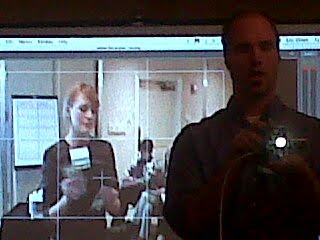
In little over 60 minutes, Christie Nicholson and Eric Olson delivered a crash course on video reporting for beginners.
They passed around a sample starter kit (a $112 Kodak Zi6 pocket video camera, a tripod, and an ear mic) and got down to business by offering tips via video example. It’s the do’s and don’ts of news clips – here they are:
1. Keep it short. News videos should last about 2 minutes. And you’ve got about 20 seconds before your audience goes South, warned Nicholson, a freelance contributor to Scientific American.
2. Attract the viewer. Aim for visually pleasing scenes (i.e. not a researcher in his chair.) As for audio, don’t shy away from sounds and music. And regarding the script, remember humor. By example, Olson, an audio-video editor at Nature, showed us one of his videos, in which he begins a story by asking why anyone would smash rabbit bones.
3. Stop the tape. Don’t be afraid to turn off the camera to ask your source to repeat something that didn’t come out quite right. If an ambulance zooms by, stop and start again. If it’s windy, relocate.
4. Divide composition space into thirds. Nicholson and Olson illustrated this lesson by projecting live videos onto a screen with a 3-by-3 grid overlain. The subject does not sit front and center, but rather fills up two of the columns – eyes line up with the bottom of the top row. NASW attendees tried it out for themselves by composing mock interviews. In the video posted here, Nancy Huddleston of the National Academy of Sciences does a nice job of lining up her mock-interviewee, Mel Berkowitz of Interon Productions in Jamaica, New York.
5. Record footage beyond the interview. In the film world, that’s called B-roll. To demonstrate, Olson shot a mock-video of Nicholson counting money.
6. Use a tripod. And avoid moving the camera around, zooming in or panning out.
7. Interview tips: Ask three questions before your serious questions begin to warm-up the interviewee. And then for nice color, ask people to talk about themselves.
Very nice summary of the main points in this very informative workshop. Some other points raised:
ReplyDelete--cut on a voice dropping, not rising.
--don't try to use equipment that records sound separately from the image, and then synch it later.
--for voice over, push your words, emphasize them more than you would in speech, and especially at the end of a line.
--concentrate most on making the sound perfect, then the image.
-four components of a video: on-camera interviews, voice over, B-roll, and establishing shots.
--four channels of information: music, natural sounds, voice-over/talking head, and image
--5-7 seconds per shot
--~300 words for a 2-minute video
--teach your interviewee to phrase the question within the answer.